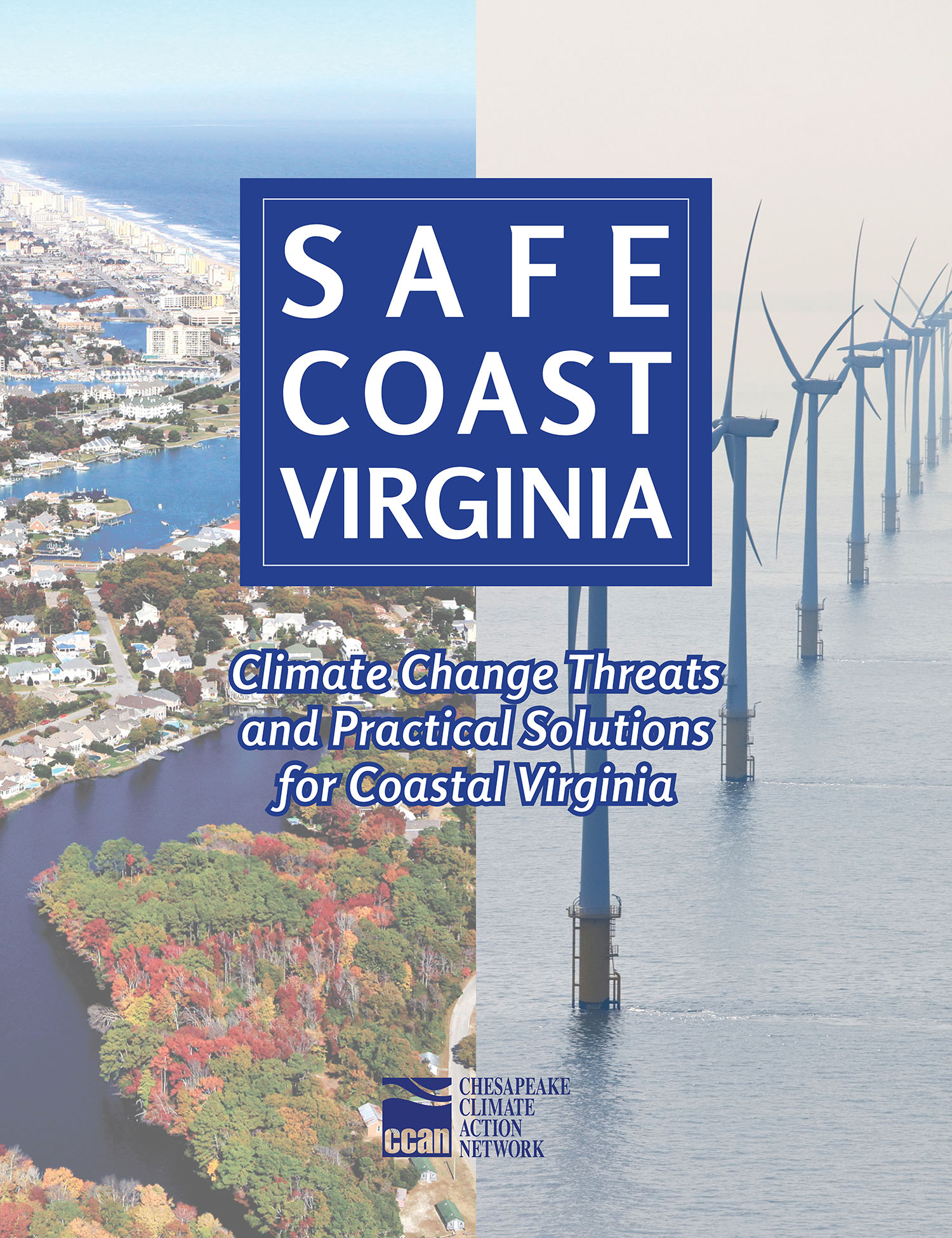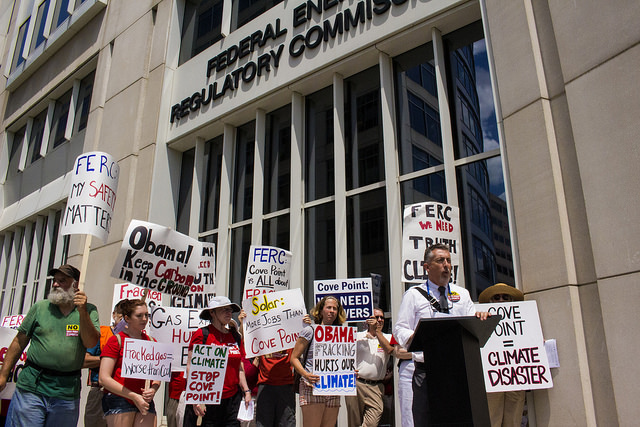FOR IMMEDIATE RELEASE
July 13, 2014
CONTACT:
Kelly Trout, 717-439-0346 (cell), 240-396-2022, kelly@chesapeakeclimate.org
Kate Fried, 202-683-4905, kfried@fwwatch.org
Activists March on Obama Energy Commission to Demand a Halt to Fracked Gas Exports
Chants of ‘Stop Cove Point’ echo through the streets of Washington, D.C. as federal regulators weigh the first proposed East Coast LNG export terminal
WASHINGTON, DC—Anti-fracking and climate activists from across the Mid-Atlantic region and beyond joined a first-ever “people’s march” on the Federal Energy Regulatory Commission (FERC) this afternoon to protest the gas industry’s push to export liquefied natural gas (LNG) from U.S. coastlines. With a key decision nearing on the Cove Point export terminal proposed in Lusby, Md., just 50 miles south of the White House, protesters are calling on President Obama and FERC to halt approval of all LNG export projects and instead promote true clean energy solutions.
“We’re here today to stand up for clean air, drinking water and real solutions to the climate crisis,” said Sandra Steingraber, PhD, New York-based biologist, author, and science advisor to Americans Against Fracking. “With LNG exports, the only things Americans get are terrifying new health and safety threats, worsening climate instability, and higher heating bills, all so that the gas industry can make bigger profits from fracking us.”
Today’s protest united well over a thousand people from New York to Maryland to Louisiana, including many who would see firsthand impacts from the gas industry’s proposed export build-out. The rally began near the U.S. Capitol and culminated with a mile-long march to the doorstep of FERC. Marchers carried a 100-foot-long “Stop Cove Point” pipeline prop and giant banners depicting the chain of harmful impacts that proposed LNG export terminals would trigger—from expanded fracking wells to new pipelines and compressor stations to enormous amounts of planet-warming pollution.
View photos at: https://www.flickr.com/photos/chesapeakeclimate/sets/72157645668842344/
Speakers repeated a common theme: FERC is endangering public safety and undermining President Obama’s own climate action plan by moving to rubber-stamp LNG export projects without comprehensive reviews of their human health or environmental impacts.
“For far too long, FERC has served as a facilitator for the oil and gas industry, rather than a regulator for the public good,” said Craig Stevens, a sixth-generation landowner Silver Lake Township, Pa., who has disaster blowouts in his backyard creek from pipeline installation, and water, air and land contamination. “Private drilling corporations, private pipeline companies, and now private LNG facilities make all the money, while people suffer the consequences.”
“President Obama can’t solve the climate crisis while overseeing a massive expansion of fracked gas infrastructure,” said Tim DeChristopher, a climate activist who served two years in prison for non-violently disrupting an illegal oil and gas auction on public lands in Utah in 2008. “As long as our political leaders continue to fail to offer an energy plan that is appropriate for the climate crisis, we have to resist every new project that would lock us into decades of more dependence on fossil fuels.”
Signs in the crowd reading “Obama: Gas Exports = Worse than Coal,” echoed findings of accumulating studies—including by the U.S. Department of Energy—that exporting fracked gas from the U.S. to Asia would likely be worse for the climate than if Asian countries burned their own coal. Yet FERC has refused to account for this data in its environmental reviews of the Cove Point facility and two LNG export projects recently approved in Louisiana. This omission could serve as one of many potential grounds for lawsuits.
“We’re here today to deliver a ‘people’s’ environmental impact statement to President Obama and FERC,” said Rev. Lennox Yearwood, Jr., CEO of the Hip Hop Caucus. “Any project that makes climate change significantly worse has no place on a livable planet, from Cove Point to Keystone XL. No matter what FERC decides in the near-term, the people will triumph in the long-term. We’ll keep fighting until wind turbines and solar panels crisscross our coastlines, and LNG facilities like Cove Point are defunct monuments to a dinosaur industry.”
The Cove Point terminal, one of 14 under FERC review, has faced particularly fierce opposition because it would be the first on the East Coast, threatening to drain massive pools of gas from the Marcellus shale region for export to Asia, where it fetches higher prices. The $3.8 billion facility, proposed by Dominion Resources, would also be the first gas liquefaction plant ever built directly next to a densely populated residential neighborhood. Hundreds of homes are in the potential “consequence zone” for fire and explosion catastrophes. During a recent public comment period, more than 150,000 comments were submitted to FERC opposing the project.
Rachel Heinhorst, a mother of three and teacher from Lusby who lives in the home closest to the Cove Point site addressed the crowd on Sunday. “I know money is the power behind this project,” said Heinhorst. “But what about my family, and families who have already lost lives or been displaced because of gas terminals like the one Dominion desires? FERC and President Obama, please hear us. We do not deserve to live in fear of an explosion, of the water we drink, of the air we breathe.”
Today’s rally is part of a swell of grassroots activism that has emerged in recent years to resist fracking, and to challenge Obama administration policies that support it. Many in Sunday’s crowd have already faced the toxic impacts of fracking, or are actively fighting unwanted pipelines or compressor stations in their towns. They vowed to continue the fight to hold their political leaders accountable.
“Here in the Gulf, we know all too well the meaning of the word ‘sacrifice.’ Our families, our ecosystems, our life-sustaining waters, have been the lamb at the altar of these ruthless industries for far too long,” said Cherri Foytlin, author, advocate, speaker and mother of six, who works for climate justice in South Louisiana. “The end to this ritual is what the president holds in his hands. Will he divest his support from these greedy industries of the past, and help us invest in a viable future for generations yet to come?”
More than 40 national, state and community-based groups endorsed the July 13th rally. Organizing groups included Berks Gas Truth, Catskill Citizens for Safe Energy, the Chesapeake Climate Action Network, the Delaware Riverkeeper Network, Energy Action Coalition, Environmental Action, Earthworks, Food and Water Watch, Greenpeace, Public Citizen, the Sierra Club, Waterkeepers Chesapeake, and 350.org.
View photos at: https://www.flickr.com/photos/chesapeakeclimate/sets/72157645668842344/
###
For more information go to www.StopGasExports.org.






